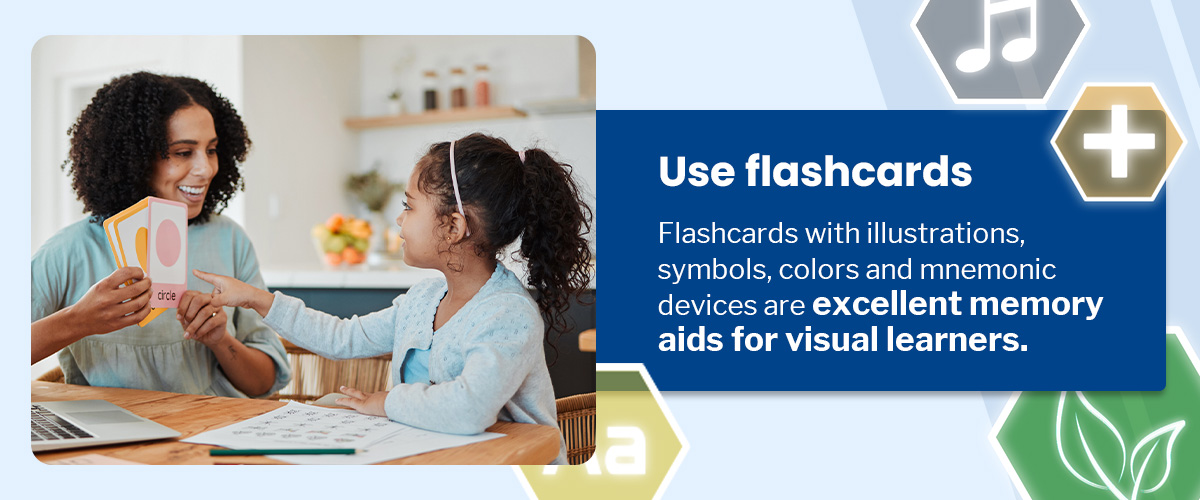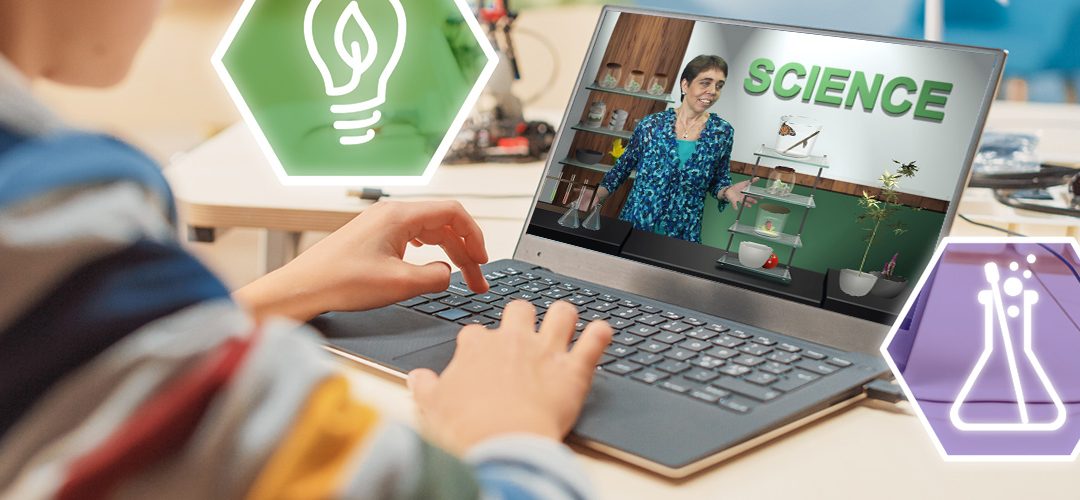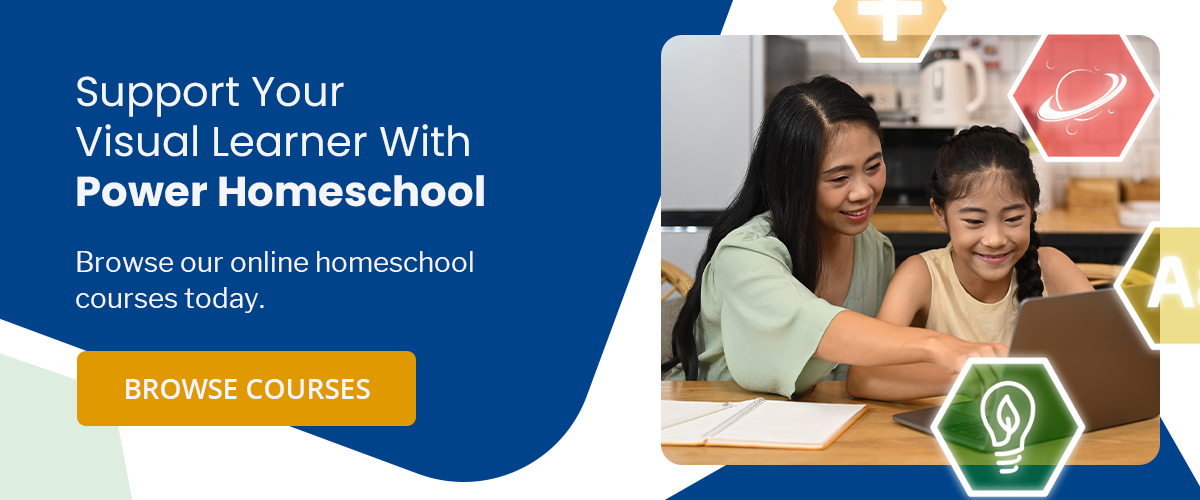The visual learning style may have valuable strengths in a homeschool environment where students benefit from a flexible program tailored to their strengths. This guide explores the characteristics of a visual learner, what a suitable homeschool curriculum for visual learners should include as well as study advice.
What Is a Visual Learning Style?
Some students learn best by seeing aspects of different topics. Aids like pictures, graphs, maps, diagrams, tables, colors and charts help visual learners perceive information. Your child might be a visual learner if they have a few of these characteristics.
- They value order and organization.
- They struggle to spell words aloud but may pass written spelling tests with flying colors.
- They may need to make lists to recall information.
- They may remember more about what they saw or read than what they heard in a lesson.
- When evaluating a visual aid, they may easily identify patterns.
- They may solve written equations faster than word problems.
- Visual learners typically express themselves better through drawing or writing than articulating their thoughts verbally.
Strengths and Weaknesses of Visual Learners
Here are some of the strengths that help visual learners retain information effectively.
- Access to resources: Look for visual learning resources online, such as video demonstrations, images and graphs, to enhance their understanding.
- Increased efficiency: Short YouTube videos can sometimes present and explain a concept within minutes, allowing visual learners to understand faster than if they read about the same topic in a textbook.
- Understanding of complex processes: You can use charts or diagrams to represent complex concepts like chemistry and physics in a way your visual learner can quickly understand.
The visual learning style also poses a few challenges.
- Requires extra time and equipment: These students may prefer color-coding or drawing pictures, which can take longer than the traditional note-taking method. They may also require students to use numerous instruments and equipment, such as rulers, highlighters, a compass and a laptop, to reference digital visual aids for better understanding. A flexible and inclusive homeschooling curriculum is an ideal solution to accommodate these needs.
- Difficulty following lectures: Visual learners may have trouble following lessons without aids like photos, flashcards, slides, videos or charts. They can lose track of what the instructor says, especially if they have delayed auditory processing.
Study Advice for Visual Learners
Visual learners can use various techniques to improve concentration, comprehension and memory retention. Here’s how to study as a visual learner.
- Try color coding: It might help your student to associate different colors with specific themes. For example, they might apply green highlights to concepts they expect to be on an exam and yellow to concepts they are still learning. Color-coding their notes or textbooks can help them differentiate between topics and remember the complex concepts they highlighted.
- Create a visual study guide: Allow your child to add drawings, symbols and mindmaps to their study notes to help them comprehend concepts and break up content. It might also help them to learn shorthand or other alternative handwriting systems to speed up their note-taking.
- Do visual practice quizzes: Visual students may stay more engaged with gamified quizzes that have visual elements. Students can create practice tests based on study guides, past exams, recent class assignments and chapter notes. They may then add game elements to academic concepts and reward themselves when they get a specific number of answers correct.
- Use Google and YouTube: Encourage your child to use resources like Google and YouTube to study complex concepts. The internet is an abundant source of visual demonstrations, flowcharts, pictures and other graphic organizers to illustrate the relationships between different ideas.

- Use flashcards: Flashcards with illustrations, symbols, colors and mnemonic devices are excellent memory aids for visual learners.
- Make outlines: Encourage your child to format their notes as an outline that includes headings, subheadings, indentations and bullet points. Outlining makes it easier for a visual learner to process relevant information. Your student can cross completed sections off as they go along, showing at a glance what they have left to review.
- Make the study area visually appealing: Students benefit from quiet, comfortable and organized learning environments. Consider elements like the view, lighting, temperature, acoustics and air quality. Provide them with notebooks, pens, stickers and stationery organizers to help their creativity flourish. Wall displays made with posterboard may also offer a visual example your child can see daily to help them remember fundamental concepts.
What Should a Suitable Homeschool Curriculum for Visual Learners Include?
While the above visual learner study tips may help boost academic performance, a curriculum that supports visual learner strengths and needs can keep them interested and engaged. Here are a few things your child’s homeschool curriculum might include to support their unique learning style.
- Visual multimedia formats: Select an online homeschool program that offers visual demonstrations and video-based lessons. Stimulating a visual learner’s unique learning style lets them grasp information quickly.
- Interactive resources: A homeschooling program with a parent support group allows you to connect with other homeschooling parents to organize interactive learning experiences. For example, you might arrange for your child to take visual practice quizzes and gamified lessons with other homeschool students.
- Course progress visibility: Since these students like staying organized, a homeschool curriculum that updates students on their weekly goals and progress might help them establish their core weekly priorities.
- Live class monitor tools: This technology allows homeschooling parents to monitor where students spend most of their time during lessons. You can then implement additional resources, such as demonstration videos and images, to encourage your visual learner to absorb content better.
Support Your Visual Learner With Power Homeschool
The visual learning style offers various ways to retain valuable information. If your child is a visual learner, you can enroll them in a curriculum that builds on their unique academic strengths.
Power Homeschool is the official provider of hundreds of Acellus® courses and offers resources to create an excellent educational experience for families. These include interactive multimedia formats and live class monitor tools, and they’re flexible and self-paced to accommodate extra time your child may need to implement visual learning practices. We welcome you to explore Power Homeschool resources and browse our online homeschool courses today.



